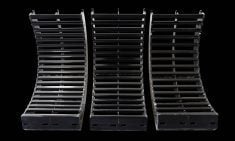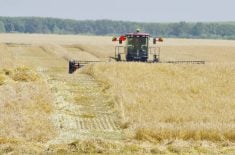Overview
Harvest progress sits at 90 per cent complete across the province, having caught up to the 5-year average of 91 per cent complete by week 42.
Harvest is wrapping up or done in many areas of southern Manitoba, and fall fieldwork, tillage, fertilizer application and drainage is underway.
Read Also

Manitoba canola embattled by verticillium
Verticillium stripe pressure has been growing in Manitoba, and canola farmers still have precious few tools to protect their crop from the disease.
Winter cereal crops appear in good condition, but soil moisture is low in those fields and many other areas. Rainfall is needed to recharge soil moisture reserves ahead of spring planting.
Some canola remains unharvested in parts of the Southwest, Eastern, and Interlake regions where late seeding has resulted in late-harvested crops, which are slow to drydown and condition for longer-term storage, leaving those producers frustrated with harvest delays.
Corn harvest has started, and is most advanced in the Red River Valley of the Central region. Yields are reported between 150 to 200 bu/acre on average.
Fertilizer application is ongoing, with some broadcast fertilizer being applied, while many farms choose to band granular nitrogen or anhydrous ammonia as soils cool below 10 C.
Cereals
Spring cereal grains
Wheat harvest is virtually complete across the province, yields have generally been average to above average, with very good grain quality for the bulk of the crop, and some downgrading occurring on the late- harvested grain affected by rains and high humidity and frost.
Oat harvest has wrapped up, with only a scattered few fields still left to harvest. Milling quality has dropped on late-harvested fields, while fields finished in September are generally higher quality.
Barley yields have generally been above 60 bu/acre in all regions, and harvest is complete. Buyers are pleased with low vomitoxin levels for the feed-use market.
Corn
Corn is drying down further following frosts and strong winds, current crop moisture ranges from 19 to 26 per cent.
Harvest is most advanced in the Red River Valley, and corn is coming off the field fairly rapidly. Harvesting speed is limited by grain drying capacity at this time.
Corn yields from the Central region have been very good, all reports are above average at 150 to 200
bu/acre.
Oilseeds
Canola
Harvest advanced in canola again this past week, with many areas finished, while local districts in the Southwest region north of PTH 16 still have a substantial number of acres to combine.
Average canola yields vary, with a 20 to 60 bu/acre spread across much of the province. The provincial average yield at 42 bu/acre is in line with the 10-year average for Manitoba.
Remaining canola crop is drying down very slowly, and is hard-threshing through the combine. Artificial drying and aeration is necessary to condition seed for longer-term storage.
Flax & sunflowers
Most flax crops are harvested in the Eastern and Central regions, and yields have generally been very good, above 30 bu/acre to 55 bu/acre.
Average flax yields in the Southwest are between 25 to 30 bu/acre, while Interlake flax crops haven been averaging 25 bu/acre.
Sunflowers harvest is in several stages, depending on region and local district. Some farms are finished, while others are waiting for the crop to dry down further.
Sunflower harvest is estimated at 25 per cent complete in the Central region, most farms expect to finish in the next week to 10 days, while producers have been forced to wait for better weather in the Eastern and Interlake regions, and are just starting in the Southwest.
Sunflower yields have been good to better than expected, with more plump kernels and fewer empty shells than in 2021. Average yields are between 2,000 to 2,300 lbs/acre.
Pulses
Soybeans
Soybean harvest is nearing completion in most regions, and is proving easier to harvest and drying down better for many producers than canola that still remains on the field.
Early-season soybeans were yielding between 40 to 50 bu/acre, while long-season soybeans were yielding 50 to 65 bu/acre, both with good crop quality.
Soybean yields vary widely in the Northwest, from 20 to 60 bu/acre, with approximately half the crop harvested there.
Dry edible beans
Dry bean harvest is virtually complete. Very good yields reported, with many bean classes yielding between 2,000 to 3,000 lbs/acre.
Crop quality has been good, with low disease incidence. Edible bean quality has been acceptable to processors this year.
Forages & livestock
Forages
Grass hay and alfalfa has gone dormant and grazing supply is low. Cattle remaining on pasture are being supplemented with baled hay.
Forage cutting has been forced to stop by weather conditions and calendar date, producers will attempt to bale any remaining cut forage as soon as possible, since forages lying in swath for several weeks are damaging the plants underneath.
Corn silage yields have been excellent across the province, from 14 to 20 tonnes/acre, averaging 16 tonnes/acre.
Retrieval and removal of hay and straw bales is underway, leaving some fields rutted in regions where rainfall was higher this past week.
Livestock
Dugouts and sloughs are at 50 per cent capacity in the Southwest, and are beginning to freeze over each morning.
Livestock water supplies on pasture are dropping, but remain sufficient to complete the grazing season in all parts of the province.
Fall cattle roundup from community pastures continues.
Some cattle remain on pasture, others have been moved to stubble grazing or extended grazing on cut hayfields.
Coyote populations have been noted by some ranchers as increasing, more animals are visible during daylight hours.
Regional comments
Southwest
Little to no moisture arrived in the region last week, allowing producers to continue harvest. Daytime highs were generally above 10 C, but overnight lows dropped below freezing. The region has had an average crop yield, but with considerable variation between districts and different crop types due to localized showers in July and August during key growth stages. Kochia has become more of a concern as glyphosate-resistant populations grow and spread. Many farms have tilled kochia-filled salinity-affected areas of fields, only to make the problem worse. Fall tillage and fertilizer application is underway, together with some fall herbicides.
Northwest
The week started off with nice weather and warm temperatures, and cooler fall weather set in for the rest of the week. Some areas received precipitation, with Rorketon receiving the most at 10 mm in the form of rain and snow. Overnight temperatures reached a low of -9 C in San Clara. Even though conditions were cool and windy, harvest was able to continue to progress, moving towards completion. Fields that remain unharvested are either later seeded, delayed by hail/cool weather and/or insect pressure from earlier in the year.
Central
Frosty nights and strong winds over the past week have aided crop dry down considerably. Fall field operations including tillage, fertilizer applications, ditching and tile drainage are being undertaken across the region, especially now that canola and cereal harvest is mostly complete. Heavier soils in the Red River Valley have at times been too wet for some field operations, such as ditching. A heavy rain could stop field operations for the year in parts of the Red River Valley. Farmers in the western part of the region were finding soils almost too dry for fieldwork. However, most farmers are able to progress with land preparation, though perhaps with slightly greater with wear and breakage than normal.
Crop regrowth is virtually finished. Volunteers were much easier to manage due to a late harvest and less rain than typical during harvest and killing frosts over the last week. In general farmers are be hoping for a dry, warm and open fall season to allow for continued field operations in November, especially if they grow longer maturing crops like corn or sunflowers. Most farms with corn and sunflowers in the region will be completed harvest within two to three weeks.
Eastern
Light intermittent rainfall and showers began in some parts of the region last week Wednesday, together with snowfall intermittently over the weekend. Below normal daytime and nighttime temperatures meant that snow persisted for a few days, preventing crop drydown and limited harvest progress. More grain producers have finished harvest, while most corn and sunflower crops remain in the field for a smaller number of growers. Much fieldwork remains to be done, and fertilizer application is behind last year’s pace due to unsuitable field conditions and supply chain constraints.
Interlake
Wet weather slowed harvest progress in the region this week, but generally crops are 90 per cent harvested. Grain and silage corn make up the bulk of the remaining crop, with about three weeks of harvesting left for grain, while silage corn is approximately 80 per cent cut. A few fields of every crop type remain in the field in the Arborg area, while the south Interlake is further advanced. Yields for most crops in the region have been somewhat disappointing and averages are lower than expected, with the exception of soybeans at 40 bu/acre.














